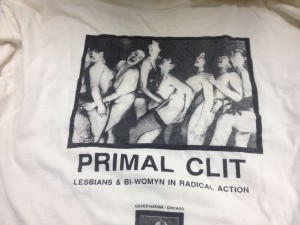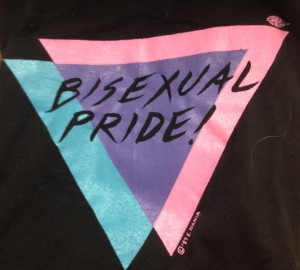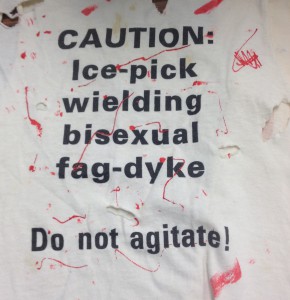In the Archives | The Melissa Ann Merry Papers
BY John D'Emilio ON October 31, 2016
 One of the pleasant surprises that comes from snooping through the collections at the Gerber/Hart Library and Archives is seeing how rich with information even small collections can be. The papers of Melissa Ann Merry are a perfect illustration of that.
One of the pleasant surprises that comes from snooping through the collections at the Gerber/Hart Library and Archives is seeing how rich with information even small collections can be. The papers of Melissa Ann Merry are a perfect illustration of that.
Merry was a Chicago-based bisexual activist and performer. Born in Canton, Ohio, in 1963, she went to college at Eastern Michigan University and then moved to Chicago soon after graduating in 1986. It was in Chicago that she came out as bisexual, and she soon plunged into a world of bisexual activism that was coming together in the late 1980s and early 1990s. Locally, she got involved in the Bisexual Political Action Coalition (BIPAC) and was also a Midwest representative to the national organization BiNet (Bisexual Network of the USA), which grew out of the first national bisexual conference, held in San Francisco in June 1990. The papers she donated to Gerber/Hart consist of three boxes of material, almost all from between 1990 and 1995.
The first thing that emerged very clearly from surveying Merry’s papers is how important both the 1993 March on Washington and the 1994 Stonewall ’25 commemoration in NYC proved to be for bisexual activism and mobilization. Merry has several folders of material on each of them. First there was the organizing that needed to happen in order to have “Bi” be included in the official name of the 1993 March. Once that was achieved, planning for the March provided a great spur to local organizing across the U.S. to make sure that bisexuals participated in and were targeted by the efforts to guarantee a vast turnout in Washington in April 1993. Thus, the March proved to be not a single event, but a tool that had consequences afterward in the heightened level of local organization that it produced. The same can be said of the buildup for and aftermath of Stonewall ’25, which brought massive numbers of people to New York and achieved extraordinary media visibility. Not only did more local organizing emerge from both of them, but they also led to higher levels of national networking.
 The increasing breadth and depth of bisexual organizing also emerges from another feature of Melissa Ann Merry’s papers. The collection contains a substantial number of bisexual publications from the early to mid-1990s. Among them are Anything That Moves, from the San Francisco Bay Area; Bi-Lines, from Madison, Wisconsin; Bi-Monthly from Champaign-Urbana, Illinois; the Boston Bisexual Women’s Network Newsletter; North Bi Northwest, out of Seattle; Bi-Atlanta; Bi-Centrist, from Washington, DC; Bi-Lines, from Chicago; and Bi-Focus from Philadelphia.
The increasing breadth and depth of bisexual organizing also emerges from another feature of Melissa Ann Merry’s papers. The collection contains a substantial number of bisexual publications from the early to mid-1990s. Among them are Anything That Moves, from the San Francisco Bay Area; Bi-Lines, from Madison, Wisconsin; Bi-Monthly from Champaign-Urbana, Illinois; the Boston Bisexual Women’s Network Newsletter; North Bi Northwest, out of Seattle; Bi-Atlanta; Bi-Centrist, from Washington, DC; Bi-Lines, from Chicago; and Bi-Focus from Philadelphia.
These newsletters and community magazines suggest that bisexuals were organizing on a far more extensive scale than is commonly recognized. In rare instances, an individual might prove capable of writing, producing, and distributing such a publication. But, typically, it requires a group to do the work of gathering the information, writing it up, and building an audience to read the material and sustain the newsletter or magazine. The existence of publications like these also suggests that there were sufficient groups and issues and campaigns to write about, thereby confirming that this was a period of intense and productive bisexual activism.
 Finally, working my way through these three boxes of Merry’s papers also brought many smiles to my face. Besides documents, her collection also includes physical objects – tee-shirts, buttons, and political stickers. Many of them display a sense of humor that will easily produce chortles of laughter for the knowing but may also perhaps produce a moment of shock that successfully grabs the attention of those who may never have thought of bisexuality before. To mention just a few: there is a tee-shirt that read “Caution: Ice-pick wielding bisexual fag-dyke. Do not agitate!” Another portrays a line of women, some back-to-back and others face-to-face, with looks of ecstasy on their faces and the words “Primal Clit: Lesbians and Bi-Womyn in Radical Action.” There were stickers, meant to be placed on poles and walls and cars, one of which read “Bisexuals Don’t Sit on Fences. We Build Bridges!!!” And, finally, many buttons, among them the following: “I’m Bisexual – You’re Confused”; “Bi-Sexuals Are Equal Opportunity Lovers”; and “Two Roads Diverged in a Yellow Wood . . . and I Took Both.”
Finally, working my way through these three boxes of Merry’s papers also brought many smiles to my face. Besides documents, her collection also includes physical objects – tee-shirts, buttons, and political stickers. Many of them display a sense of humor that will easily produce chortles of laughter for the knowing but may also perhaps produce a moment of shock that successfully grabs the attention of those who may never have thought of bisexuality before. To mention just a few: there is a tee-shirt that read “Caution: Ice-pick wielding bisexual fag-dyke. Do not agitate!” Another portrays a line of women, some back-to-back and others face-to-face, with looks of ecstasy on their faces and the words “Primal Clit: Lesbians and Bi-Womyn in Radical Action.” There were stickers, meant to be placed on poles and walls and cars, one of which read “Bisexuals Don’t Sit on Fences. We Build Bridges!!!” And, finally, many buttons, among them the following: “I’m Bisexual – You’re Confused”; “Bi-Sexuals Are Equal Opportunity Lovers”; and “Two Roads Diverged in a Yellow Wood . . . and I Took Both.”
As I said at the beginning of this post, the Melissa Ann Merry Papers might be seen as a relatively small collection of three boxes, but they are packed with material that, cumulatively, provides rich insight into key years of bisexual activism in the United States.









Comments